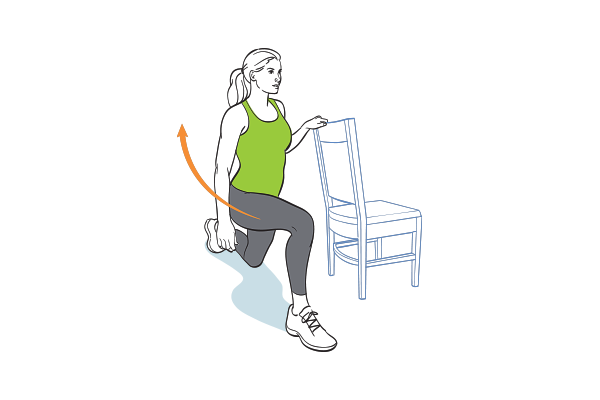12 ways to workout when the only prop you've got is a chair
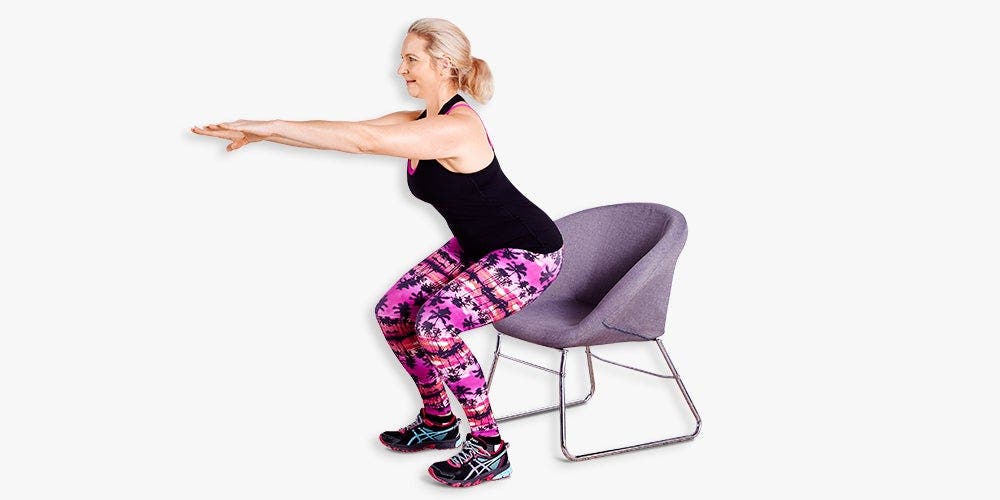

Nowhere is it written that for an exercise program to be successful it must include complicated movements done with lots of equipment. Truth be told, the most effective workout is the one you’ll do—and continue to do—regularly.
With that in mind, we’ve designed a chair-based lower body routine suited for all levels, from newbies to seasoned exercise enthusiasts alike. It focuses on the muscles of the legs, butt, and core. Some of the movements are done seated, while others are done standing. Either way, the chair remains a part of the workout and will assist you in strengthening your lower half. And to ensure you get the most out of this program, some of the exercises we’ve included also work core and stabiliser muscles, which help improve balance.
So what are you waiting for? Grab a chair and some water, and let’s go!
Guidelines for a great chair workout
- Use a chair that does not have arms or wheels.
- During seated exercises, sit on the edge of the chair with both feet on the floor. Chair height should allow your feet to be firmly planted. Keep ankles, knees, and hips aligned as you perform each movement.
- During standing exercises, maintain good posture, keeping shoulders aligned with your hips, and your spine neutral. Stack your shoulders over your hips, and brace your abdominals to help support your body.
- Sit—or stand—tall with your shoulders relaxed, not hunched up toward your ears.
- Breathe in during the lowering phase of the exercise, and start your exhale about halfway through the lifting phase, exhaling completely at the top of the movement.
- If you feel pain or discomfort in your back, take short posture breaks then return to the workout.
- For greater intensity, increase range of motion. For less intensity, shorten the range of motion; don’t move as deeply into each repetition.
- Count two seconds up and two seconds down when executing each movement. When unsure about your pace, err on the side of going slower.
Lower-body chair workout
| Exercises | Rounds | Reps |
| Warm-up | 5 mins | |
| Leg extension | 1–3 | 15-20 |
| Seated heel raise | 1–3 | 15-20 |
| Chair squat | 1–3 | 15-20 |
| Plié squat with chair | 1–3 | 15-20 |
| Hip abduction | 1–3 | 15-20 |
| Curtsy lunge | 1–3 | 15-20 |
| Leg extension with external hip rotation | 1–3 | 15-20 |
| Plié squat to knee lift | 1–3 | 15-20 |
| Single-leg reach and tap | 1–3 | 15-20 |
| Standing single-leg hip and extension | 1–3 | 15-20 |
| Hip adduction | 1–3 | 15-20 |
| Reverse lunge | 1–3 | 15-20 |
| Cool-down | 5 mins |
Start off with a five-minute warm-up. Walk, march on the spot; do anything that increases blood flow to the lower body.
Do the exercises in the order they’re presented. This is one circuit. Begin with one round and work your way up to doing three as you gain strength and ability.
Take minimal rest between sets. At the end of each round, take a two-minute break before starting the next one.
Add ankle weights and dumbbells to the workout where indicated, if you’d like.
Cool down for five minutes by walking and stretch the muscles of the lower body when you’re done.
Exercise descriptions
1. Leg extension
Body parts targeted: Quadriceps (front of thigh)
Get set: Sit at the edge of the chair, feet on the floor, hands on each side of the chair.
Go: Keep your upper body still while you extend and straighten your right leg, then flex your quadriceps muscles. Hold for a second before returning to the start position. Repeat for the suggested number of repetitions, then switch sides.
Make it harder: Wear ankle weights.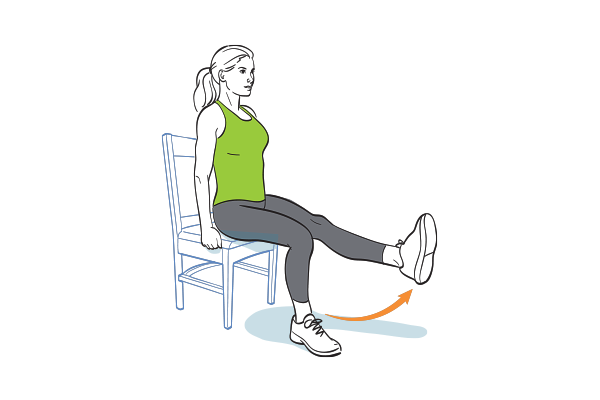
2. Seated heel raise
Body parts targeted: Calves (back of lower leg)
Get set: Sitting at the edge of the chair with feet on the floor.
Go: Slowly lift your heels off the floor, contracting your calf muscles. Pause before lowering your heels back to the floor. Repeat for reps.
Make it harder: Wear ankle weights.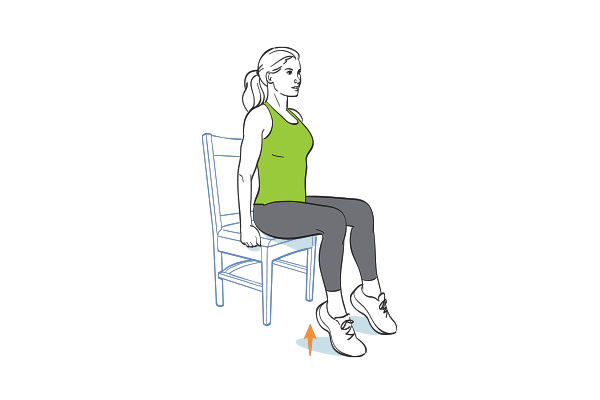
3. Chair squat
Body parts targeted: Abs (midsection), glutes (butt), quadriceps, hamstrings (back of thigh), calves
Get set: Sit on the front half of the chair seat, feet on the floor. Engage your abdominal muscles, lean forward slightly.
Go: Press through your heels to raise your body to standing. Reverse the movement and slowly lower down, tapping your glutes/bum on the end of the chair. Repeat for reps.
Tips: Avoid sitting down completely during each set. Also, be mindful not to round your back as you move through each repetition. Think about sticking your chest out.
Make it harder: Hold a dumbbell in both hands.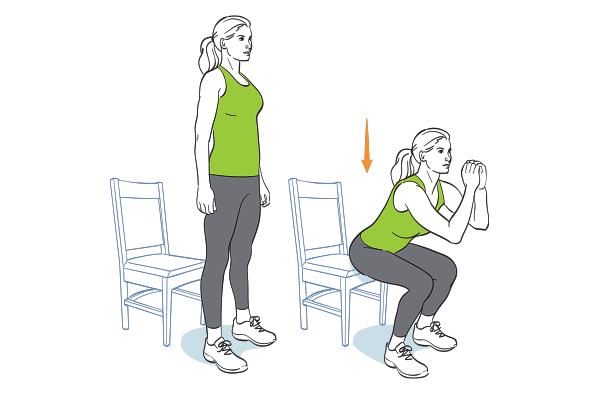
4. Plié squat with chair
Body parts targeted: Abs, glutes, hip flexors, adductors (upper inner thigh), quadriceps, hamstrings, calves
Get set: Stand behind the chair, feet wider than shoulder-width apart, and lightly grip the chair back with one hand. Point toes outward and stack your shoulders over your hips.
Go: Bend your knees—allowing them to track over your toes—and slowly lower your hips toward the floor. Drop down as far as what’s comfortable for you—or to where your thighs are parallel to the floor—then press through your heels and return to standing. Keep your posture upright throughout the move. Repeat for reps.
Make it harder: Hold a dumbbell at chest height in your free hand.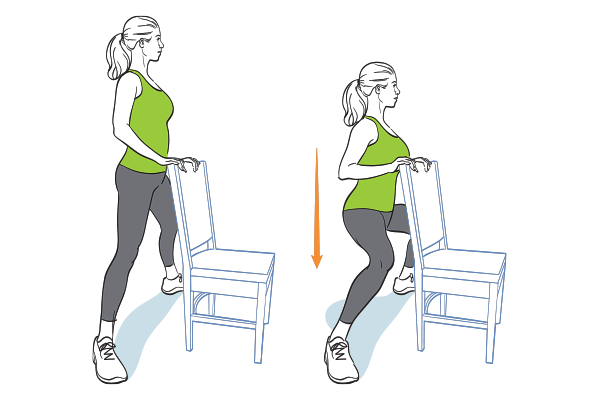
5. Hip abduction
Body parts targeted: Glutes, hip flexors, abductors (upper outer thigh)
Get set: Stand behind the chair with feet hip-width apart and your knees slightly bent, and lightly grip the chair back.
Go: Flex your right foot and raise your right leg directly out to the side, as high as you can without moving your upper body. Keep shoulders over your hips throughout the move. Pause for a second, then lower your leg, tapping your heel to the floor. Repeat for reps, then switch sides.
Make it harder: Wear ankle weights or place a light resistance band around your ankles.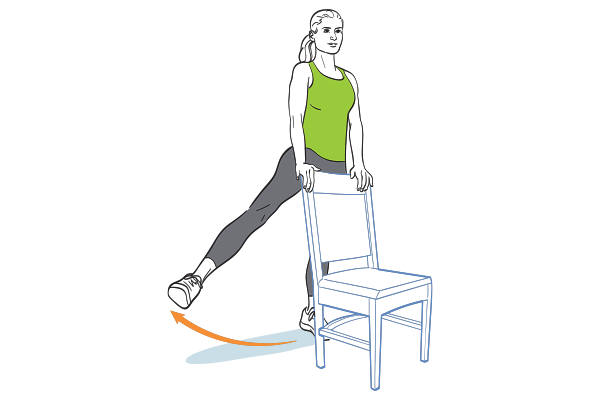
6. Curtsy lunge
Body parts targeted: Glutes, abductors, adductors, quadriceps
Get set: Stand with your right side next to the chair back, and lightly grip the top of the chair with your right hand.
Go: Step with your right foot back and to the left to the 8 o’clock position. Bend both knees as you drop into a curtsy position. Press through your left foot as you rise back to the start position. Repeat for reps, then switch sides.
Make it harder: Hold a dumbbell down by your side in your free hand.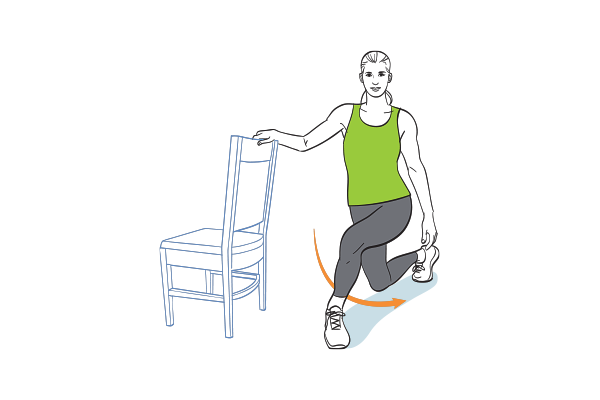
7. Leg extension with external hip rotation
Body parts targeted: Abs, hip flexors, quadriceps
Get set: Sit at the edge of the chair, feet on the floor with knees bent. Straighten your right leg and turn your toes outward.
Go: Raise your right leg so you’re lifting the arch of your foot toward the ceiling. Hold for a second. Then lower your leg, tapping your heel on the floor before beginning the next repetition. Keep your upper body still as you move. Repeat for reps, then switch sides.
Make it harder: Wear ankle weights.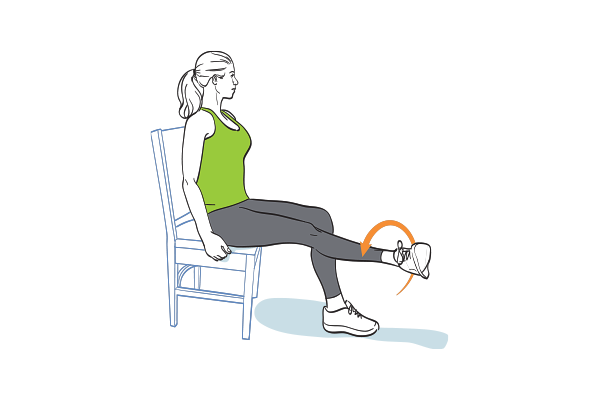
8. Plié squat to knee lift
Body parts targeted: Abs, glutes, hip flexors, adductors, quadriceps, hamstrings, calves
Get set: Stand with your right side next to the chair back, and lightly grip the top of the chair.
Go: Take a wide step out to your left. Do a plié squat, lowering your hips straight toward the floor. Press through your heels to stand, then raise your left knee to hip height. Return to the standing position. Repeat for reps, then switch sides.
Make it harder: Hold a dumbbell in your free hand.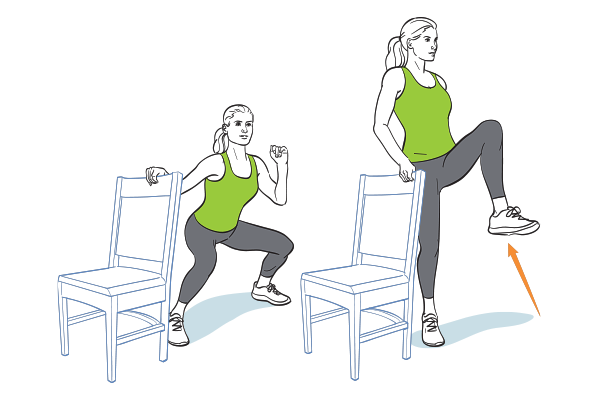
9. Single-leg deadlift
Body parts targeted: Glutes, adductors, hamstrings
Get set: Stand with your right side next to the chair back, and lightly grip the top of the chair with one hand. Pull your shoulders down and back. Balance on your right foot, keeping a slight bend in the right knee.
Go: Slowly hinge forward at the hip, allowing your left leg to rise behind you. Keep your spine neutral as you lower and reach your left hand toward your right foot. When you cannot descend any lower, press through your right heel to rise back to standing. Maintain balance on that right foot between reps, if possible. Repeat for reps, then switch sides.
Make it harder: Hold a dumbbell in your free hand.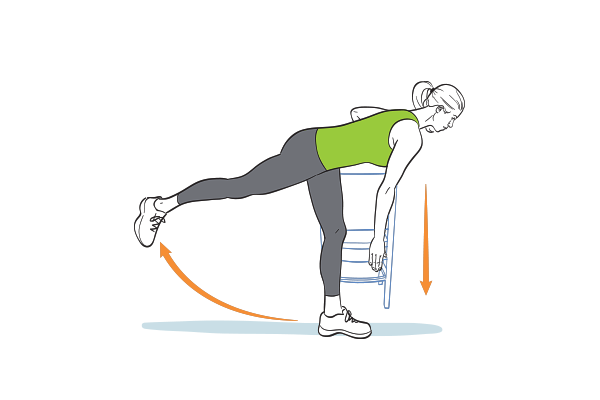
10. Single-leg glute kickbacks
Body parts targeted: Glutes and hamstrings. Note that bending the knee of your standing leg works the glutes more. To work the hamstrings more, try this exercise with a straight leg.
Get set: Stand feet hip-width apart with soft knees facing the back of the chair; lightly grip the chair back. Balance on your left foot and bend your right knee about 45 degrees.
Go: Extend your right leg up and back by pressing through your right heel, lifting the leg. Squeeze your right butt cheek at the top of the movement, then slowly lower your leg, but don’t allow it to touch the floor during the set. Stand tall throughout the entire exercise. Repeat for reps, then switch sides.
Make it harder: Wear ankle weights.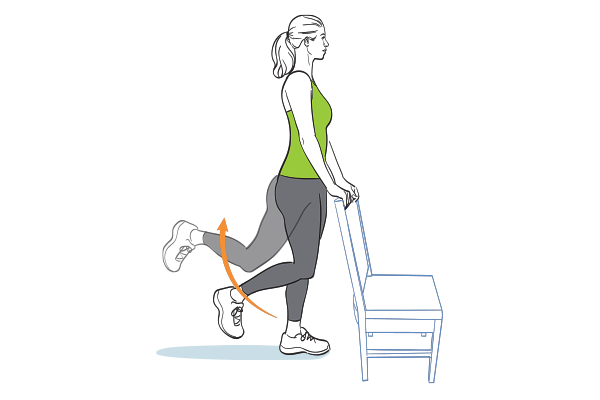
11. Hip adduction
Body parts targeted: Adductors
Get set: Stand feet hip-width apart with your right side next to the chair back; lightly grip the top of the chair. Pull your shoulders down and back. Flex your right foot and balance on your left leg, keeping a slight bend in both knees.
Go: Cross your right leg in front of your left leg as far as possible without moving your upper body. Pause for a second, then reverse the motion to return to the start position. Repeat for reps, then switch sides.
Make it harder: Wear ankle weights.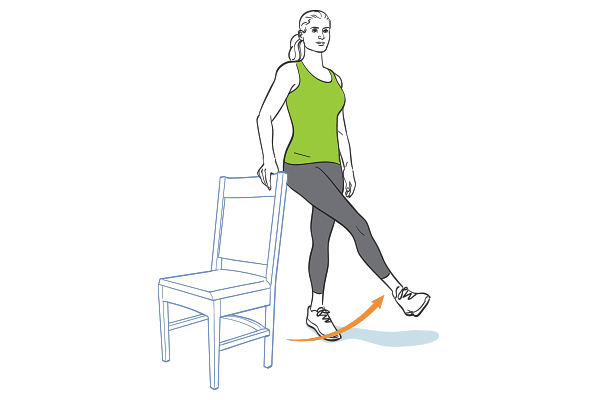
12. Reverse lunge
Body parts targeted: Glutes, quadriceps, adductors, calves
Get set: Stand feet hip-width apart with your right side next to the chair back; lightly grip the top of the chair with one hand. Pull your shoulders down and back.
Go: Step your right leg straight back. Bend both knees to lower your body down toward the floor. Make sure to not go lower than having both knees bend past 90-degree angles. Press through your left heel as you reverse the motion and return to the standing position. Repeat for reps, then switch sides.
Make it harder: Hold a dumbbell in your free hand.